Is Paddle Boarding Healthy?
We’ve all heard the claims that SUP is good for our physical and emotional wellbeing. And sure, intuitively it makes sense. I mean, surely balancing on a wobbly board has to be good for our core and stability, paddling with our upper body has to increase strength, and increasing our paddling speed results in a good cardio workout. Right?
Well, there is actually surprisingly little scientific research done on the benefits of SUP. So a PHD student, Ben Schram, wrote a doctoral thesis in an effort to answer these and other questions. I’ve summarized what I think are the most interesting findings below.
What evidence exists that SUP is beneficial?
Ben acknowledges that there are currently numerous anecdotal reports around the benefits of SUP around fitness, core strength and balance, but the limited research previously conducted suggests that most SUP participants don’t actually reach their anaerobic threshold (80% of max heart rate).
Why hasn’t this question been answered already?
The short answer is because the sport has only become popular relatively recently. As SUP is essentially a combination of other sports that do have some research behind their benefits, it makes intuitive sense to assume SUP will also carry these benefits. These assumptions are:
1. Improves Balance
The continuous need to rebalance whilst motionless and paddling, combined with the neutral power stance, forces the SUP paddler to utilise muscles for posture.
2. Builds core strength
Core trunk muscles are required to be used when paddling in the standing position.
3. Increases upper body strength
Propulsion of the SUP relies on using muscles of the upper body and paddling on alternate sides of the SUP prevents any muscle imbalances from unilateral paddling. The standing position decreases pressure on the spine that can be associated with rotational movements.
4. Relieves back pain
Multi-muscle exercises have been proven to be more effective than isolated muscle training for strengthening back (paraspinal) muscles. And exercises performed in a neutral spine position lead to better outcomes. Both these points potentially indicate that SUP can be an effective rehabilitation exercise for certain types of back pain.
5. Low impact
No repetitive impact on the joints makes it low impact and SUP may actually be significantly less dangerous than surfing.
Whilst similar to surfing, SUP is unique in that the paddler is already standing, thereby avoiding the “pop-up” stage that can induce stress on the back. The lower back and neck are the most common reported injuries from surfing.
6. Rehabilitation tool
Unstable surface training program might be an ideal initial exercise to prevent the loss and force often associated with injury.
7. Bare foot benefits
SUP activity requires foot muscles to be highly active, thereby increasing foot musculature and providing a stable base for the activity. Various inputs on the sole of the feet are also thought to affect postural awareness.
It is great that we do have some research around similar water sports such as surfing, canoeing, kayaking to draw some initial inferences, but all of these potential benefits are merely assumptions.
So, let’s move on to Ben’s actual findings.
SUP improves fitness
The study found that SUP participants have a high level of aerobic and anaerobic fitness.
The study separated participants into 3 groups of 15 and conducted various controlled experiments. The groups were:
- Elite competitive SUP racers: currently participating in competitions
- Recreational SUP: minimum 1 year experience in SUP and no competitive experience
- Sedentary: no SUP experience and no exercise for past 6 months
The results of the tests are included below:
Aerobic Performance
| Parameter | Elite (n = 15) | Recreational (n = 15) | Sedentary (n=15) |
| V_O2max (L/min) | 3.39 (0.63)** | 2.44 (0.77)* | 1.83 (0.57) |
| V_O2max (ml/kg/min) | 43.73 (5.87)** | 31.90 (7.68)* | 20.35 (3.69) |
| Respiratory exchange ratio | 1.13 (0.05) | 1.16 (0.11) | 1.18 (0.07) |
| HRpeak (bpm) | 186.60 (15.00) | 187.6 (13.71) | 173.93 (17.21) |
| Peak lactate (mmol/L) | 13.70 (3.59) | 12.43 (3.56) | - |
| Aerobic power (W) | 30.50 (5.98)** | 21.23 (7.86)* | 10.56 (3.21) |
| Peak stroke rate (strokes/min) | 69.60 (10.59)** | 55.47 (7.99)* | 42.27 (9.02) |
| Average stroke length (m) | 2.19 (0.28) | 2.24 (0.27) | 2.34 (0.48) |
| Distance covered (m) | 747.59 (128.66)** | 503.51 (159.97)* | 368.90 (68.42) |
| Peak speed (m/s) | 2.18 (0.16)** | 1.93 (0.24)* | 1.50 (0.15) |
** significant difference to recreational
* significant difference to sedentary
Anaerobic Performance
| Parameter | Elite (n = 15) | Recreational (n = 15) | Sedentary (n=15) |
| Anaerobic power (W) | 35.67 (11.08)** | 25.04 (11.69)* | 13.44 (7.05) |
| Relative anaerobic power (W/kg) | 0.46 (0.12)** | 0.32 (0.13)* | 0.15 (0.06) |
| Peak speed (m/s) | 2.35 (0.32)** | 1.99 (0.40)* | 1.62 (0.31) |
| Distance covered (m) | 20.60 (3.08)** | 17.29 (3.60)* | 14.07 (2.88) |
SUP Maximum Aerobic Power
One of the most fundamental ways to measure exercise physiology is through maximal oxygen uptake (VO2max). I’ve isolated this test data below:
V_O2max (ml/kg/min) of SUP Participants
| Elite | Recreational | Sedentary |
| 43.73 | 31.9 | 20.3 |
Notice the increase in VO2max from the sedentary group compared to the recreational group, and the increase again to the elite group. This suggests that VO2max increases with SUP activity. So, the more you SUP, the higher your aerobic capacity becomes.
How does SUP compare with other water sports
The VO2max results obtained from the elite group can be used as both an aspirational qualities for those of us considering SUP competition, and to compare against the performance of other similar water sports. The results were comparable with other water sports that are also upper limb dominant.
VO2max (ml/kg/min) Capacities of Upper Limb Dominant Water Sports
| Sport | Min | Max |
| Surfing | 37.8 | 54.2 |
| Canoeing | 44.2 | 51.9 |
| Dragon Boat Racing | 42.3 | 50.2 |
| SUP | 46.84 |
Stroke length
The relationship between stroke length, distance covered and peak speed was interesting. This table is below:
| Parameter | Elite | Recreational | Sedentary |
|---|---|---|---|
| Average stroke length (m) | 2.19 | 2.24 | 2.34 |
| Peak stroke rate (strokes/min) | 69.6 | 55.47 | 42.27 |
| Distance covered (m) | 747.59 | 503.51 | 368.9 |
| Peak speed (m/s) | 2.18 | 1.93 | 1.5 |
The sedentary group had the longest stroke (2.34m), but covered the least distance and had the slowest peak speed. The elite group had the shortest stroke length (2.19m), covered the most distance and obtained the highest peak speed. The recreational group was in the middle for all metrics. The take away, don’t look to increase your stroke length if you are looking for speed gains.
SUP improves balance
The study concluded that the more you SUP, the greater your balance appears to improve.
The 3 groups also participated in tests designed to measure stability through a series of 6 postures by placing 3 sensors on the foot and measuring movement. The tests were conducted with both eyes closed (EC) & eyes open (EO). The results of these tests are below (the less movement, the more stable):

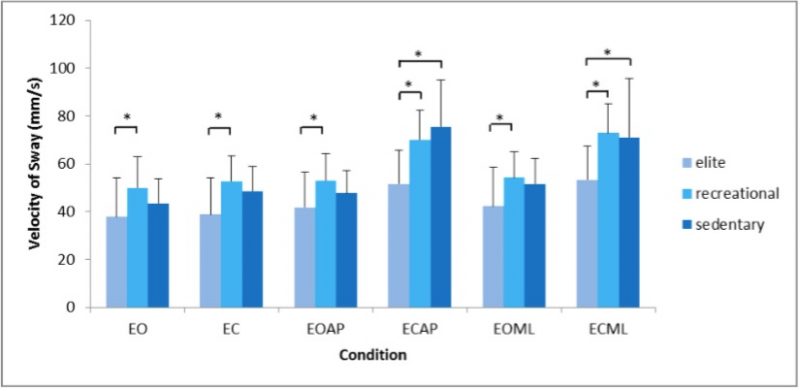
In both of these tests, the elite group had significantly better balance than the sedentary group.
SUP increases core strength
There is a high level of core muscle endurance amongst those who participate in SUP.
Core strength was measured through endurance tests where the participants of each group were timed how long they could hold the four positions.
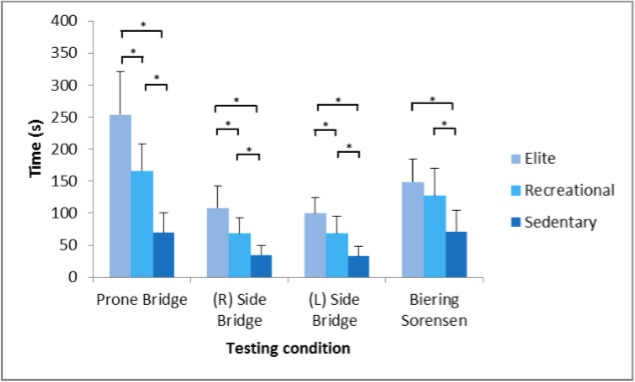
The relationship of increased SUP activity and on core strength can quite easily be seen across all four tests. The message here is clear; more SUP activity results in better core strength.
SUP makes you happier
Quality of life measures improved significantly across physical and psychological heath.
I found this section to be the most interesting part of the thesis. This was a different series of tests performed on one group of participants that had not participated in physical activity for the past 6 months. The group trained on SUPs for three, one-hour sessions each week for 6 weeks, with a range of measurements taken before and after the “intervention” or testing period.
The following graph shows self reported data across a range of quality of life measures.
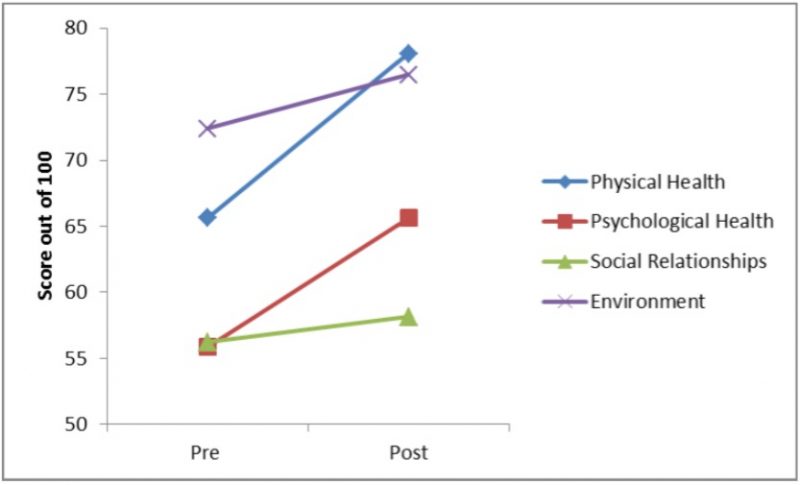
Yes, physical health increased by 19%, but psychological health also increased by 17.5%. So it appears as though SUP does actually make you happier.
The factors the participants included in the psychological evaluation were:
- Bodily image and appearance
- Negative feelings
- Positive feelings
- Self-esteem
- Spirituality/Religion/Personal beliefs
- Thinking, learning, memory and concentration
SUP benefits are beginner friendly
SUP can increase the fitness and strength of previously untrained individuals.
The “intervention” tests after the 6 weeks showed improvement across all areas, including aerobic, anaerobic and core strength.
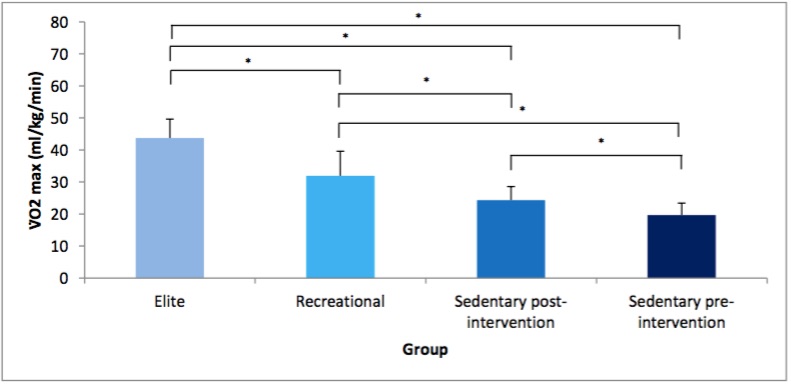
This graph shows the significant increase in aerobic capacity after the 6 week training intervention. Sure, there is still a gap until the capacity of the recreational SUP participants is reached, but the improvements after just 6 weeks are still impressive.
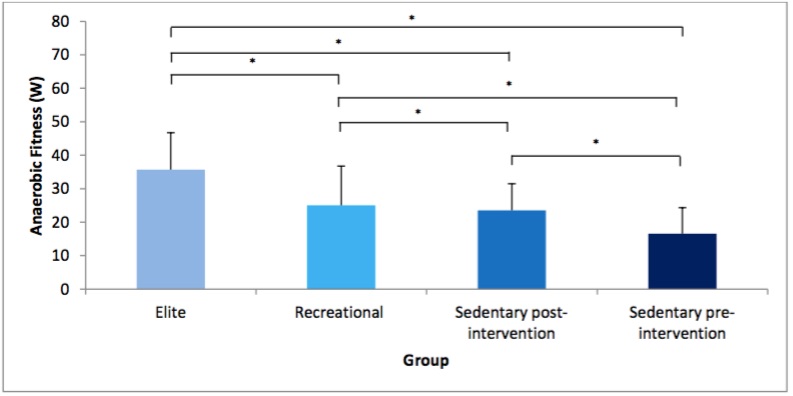
The increase in anaerobic fitness after the intervention is very impressive, reaching levels similar to that of the recreational SUP participant.

This graph shows results from one of four different endurance tests to measure core strength. The intervention group showed significant improvement, but it does appear as though more than 6 weeks training will be required to obtain similar core strength to recreational paddlers.
The substantial gains across fitness and core strength after just 6 weeks is great news for SUP beginners that are looking at getting into a sport that can show results quickly. If this is you, you might also want to check out our iSUP Beginners Guide.
This is the first study of its kind that we can point to and clearly answer some of the unknowns around a sport that, to many of us, make intuitive sense. I hope this study paves the way for some larger studies to be completed, particularly around the long-term effects of SUP on fitness and mental wellbeing.




